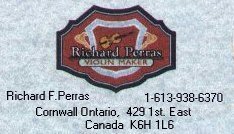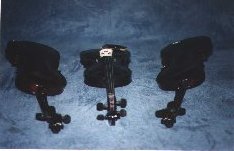Violin`s & Accessories Sales & Repairs


I perceive each Violin
as an individual piece
and work on it that way
Richard Perras
- Hand Carved Violin`s For Sale $2,500.00 - $5,000.00
- Student Outfits starting at $500.00 with case
- Violin strings & accessories of all kinds
- Violin`s restrung for $55.00 including the strings
- Violin repair and restoration
- Check out the F.A.Q.s below on repairs & refinishing
- Call me personally and I`ll be glad to help 1-613-938-6370
 Supported by the Austrian Embassy for his style of Jacobus Stainer Violins
Supported by the Austrian Embassy for his style of Jacobus Stainer Violins
Noted for his craftsmanship from Cornwall Regional Art Gallery
Supported by Riverdale School of Music & Riverdale String Ensemble
Supported by Ontario Arts Council
 Helpfull F. A. Q.
Warning!! All but the simplest of repairs
Helpfull F. A. Q.
Warning!! All but the simplest of repairs
should not be attempted.
Major repairs must be undertaken by a craftsman of
ample if not complete understanding of the
principles of operation. If a violin is of no apparent value
because of its obivious disrepair than certain attempts
may bring the instrument to a playable condition.
Note ! all glues must be hide glue Reason ! Hide glue crystalizes, transmitts & vibrates
Hint never use crazy glue breaks down in 2 years.
Problem 1. Pegs slipping
Try using chalk sprinkled around the contact points on the key. Still slips try alternate sanding of shinny contacts points on the key in an attempt to seat the key with maximum contact to the peg box.
Problem 2. Sealing
The key to a successfull finish lies in the sealer. This is where present knowledge is limited and speculative. Personally I make my own sealer, formulated from products originating with the trees the violins come from. To make this sealer place approx 1 lb of propolis acquired from a beehive in a double boiler. Basically a pot of water containg a second pot in the water containg the propolis, bring water to a boil and propolis will melt. All wax in the propolis will rise to the surface. All the wax must be removed, then the crystalized propolis at room temperature has to be rendered into a powder. This powder is then dissolved in ether and applied to all but the inside of the top plate. Propolis is tree bud sap collected by the bees.
Problem 3. Violin is cracked
Cracks that are straight can be repaired adequately using hide glue forced into the crack, (splices can be inserted if crack is large enough). Hint using small strong earth magnets to guide the splice or even clamp the crack.
Problem 4. What is the best finish?
I must state here that unlike most of my contemporarys I do not place great emphasis on the accoustical attributes to the finish. That is not to say that the finish should be given little consideration. Most varnish products and preparation are as good as the original finishes. Personally I prefer Oil Violin varnish over lacquers and application is quick simple using a 1" synthetic brush. The brush is worth about $10.00 but is well worth the extra.
Problem 5. Varnish is chipped off violin
1. Clean bare wood with mineral spirits to remove oils 2. Use water stain to approach colour.
3. Apply a coat of shellac 4. match colour with varnish, each coat darkens
Problem 6. Rosin build up
Rosin build up on top plate, rosin should not be left on the violin but cleaned off regularly. This will save the finish as rosin tends to eventually eat away at the varnish. If the build up is extreme, commercial cleaners are available.
Hint !!
I usually use either my fingers or palm to rub the surface. This creates heat and with a little water will rub out even surface scratches.
Question 1. Sir I have a 120 year old violin with good sound, but appears to have been re-varnished years ago. I wish to remove the finish and refinish it. I am told to avoid chemicals what do you recommend? Also im told the table requires less coats of varnish than the back and sides for tone purposes. It is chipping badly all the way down to the wood from poor handling or something. Please help me if you know the best way for me to approach this ? I am about to attempt to make my own Gum turp oil varnish from a recipe. Thank You.. Mike
Answer
The best way to remove the old varnish is to use scalpels and razor blades with various shapes to correspond with the curves and shape of your violin.Use them straight up in a side to side motion like a scraper. Be gentle and use equal force, scrape off old varnish, with patience you can do this, do not push so hard as to gouge the wood. Dont worry about sealing the violin the sealer is in the wood not on it.P.S. Dont use sandpaper,, you are ready to apply finish.
Bad Chips Then you will have to sand the instrument smooth using 150 grit and then 220 grit and then 320 grit. Sealing instrument refer to Problem 2, above.
I would strongly advise against making your own finish this task should be left to proffesionals. A violin is to precious to fool around with. Refer to Problem 4
they make good quality finishes.
Next question, from the peg box to the heel, has to be shellaqued rather than varnished, it allows your fingers to slide better than if you varnish it. But for the rest of the violin, varnish all sides equally.
Go back to StripAlls main page


 Supported by the Austrian Embassy for his style of Jacobus Stainer Violins
Supported by the Austrian Embassy for his style of Jacobus Stainer Violins 